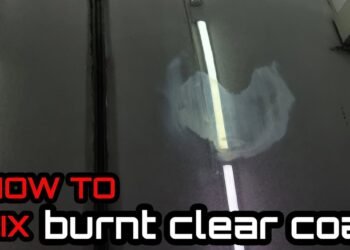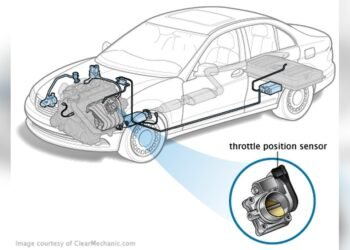To remove a stuck spark plug from an aluminum head, first apply a penetrating oil and allow it to soak in. Then, use a spark plug socket with a ratchet to gently work the plug back and forth until it loosens.
Dealing with a stuck spark plug can be a daunting task, especially when it’s lodged in an aluminum cylinder head. This common issue requires a delicate balance to avoid damaging the softer metal. A spark plug that refuses to budge is not just frustrating but can also halt your vehicle maintenance in its tracks.
Tackling this challenge requires patience, the right tools, and a methodical approach. The key is to take your time and let the penetrating oil work its magic. Understanding the intricacies of aluminum heads helps ensure that you approach the task with the necessary caution. This introduction sets the stage for a detailed guide, providing car enthusiasts and DIY mechanics with confidence as they prepare to tackle this tricky maintenance issue.
The Challenge Of Seized Spark Plugs
The Challenge of Seized Spark Plugs often frustrates many vehicle owners. Spark plugs can become stubbornly fixed within an aluminum head. This happens due to several reasons. Removing them without damage requires careful techniques and patience.
Common Causes Of Spark Plug Seizure
- Corrosion: Moisture and salt cause metal to corrode, bonding the spark plug to the head.
- Heat: High temperatures can cause metals to expand and fuse together.
- Over-torque: Applying too much force when installing can strip threads.
- Carbon build-up: Combustion residues can cement the plug in place.
Risks Of Incorrect Removal
Improper techniques can lead to costly damage. Be mindful of the risks:
| Risk | Consequence |
|---|---|
| Broken Plug | Metal pieces can fall into the cylinder. |
| Stripped Threads | Requires head repair or replacement. |
| Damage to Head | Compromises the engine’s integrity. |
Preparation Steps Before Attempting Removal
Before you try to remove a stuck spark plug, get ready first. This means you need to prepare. Doing so makes the job easier and safer. Let’s look at the steps you should take before starting.
Gathering The Necessary Tools
Gathering the right tools is your first step. Without them, you can’t start. Here’s what you need:
- Spark plug socket
- Ratchet and extension
- Penetrating oil
- Wire brush
- Torque wrench
These tools help you remove the spark plug safely. They protect both you and the engine.
Ensuring Engine Temperature Is Optimal
Next, make sure the engine is not too hot or too cold. A warm engine is best. This makes removing the spark plug easier. Here’s a simple guide:
| Engine State | Temperature | Action |
|---|---|---|
| Too Hot | Above 150°F (65°C) | Wait for it to cool down |
| Too Cold | Below 30°F (-1°C) | Let it warm up slightly |
| Optimal | Between 30°F (-1°C) and 150°F (65°C) | Proceed with removal |
An optimal temperature engine reduces the risk of damage. It makes the spark plug come out easier.
Initial Loosening Techniques
Removing a stuck spark plug from an aluminum head can be tricky. The material is soft and prone to damage. Yet, the right techniques can make this task easier. Let’s explore initial loosening methods that can help prevent damage.
Penetrating Oil Application
Start by applying a quality penetrating oil. Choose a formula designed for automotive use. Spray directly onto the spark plug area. Allow the oil to soak in for at least 15 minutes. This helps break down rust and corrosion. It can make loosening the plug much easier. A longer soak time may be necessary for severe cases.
Gentle Tapping Method
After the oil has settled, use a hammer to gently tap the spark plug. Do this with a light touch. The vibrations can help break the bond. Be cautious to avoid striking too hard. You don’t want to damage the aluminum head. This method often complements the penetrating oil.
Advanced Removal Strategies
Struggling with a stuck spark plug in an aluminum head can be daunting. Discover effective techniques to safely extract stubborn spark plugs without causing damage.
Using A Specialized Spark Plug Socket
Removing a stuck spark plug requires a specialized socket that fits perfectly.Impact Wrench: When And How To Use It
An impact wrench is handy for stubborn spark plugs, but use it cautiously. Removing a stuck spark plug from an aluminum head can be challenging. Advanced removal strategies can help ease the process.Using A Specialized Spark Plug Socket
To remove a stuck spark plug, utilize a specialized socket that fits perfectly.Impact Wrench: When And How To Use It
Consider using an impact wrench for stubborn spark plugs, but exercise caution.Heat And Expansion Tactics
When dealing with a stuck spark plug in an aluminum head, using heat and expansion tactics can be very effective. The idea is to use heat to expand the metal, helping to free the spark plug. This method requires careful execution to avoid damaging the engine components.
Careful Application Of Heat
Applying heat helps expand the aluminum, making it easier to remove the spark plug. Use a heat gun or a small propane torch. Focus the heat on the area around the spark plug, not directly on it. Heat the area for a few minutes. Be cautious to avoid overheating, which could damage the aluminum head.
- Use a heat gun or propane torch.
- Focus heat on the area around the spark plug.
- Heat for a few minutes, avoiding overheating.
Thermal Shock Technique
The thermal shock technique involves rapid cooling after heating. This can help break the bond between the spark plug and the aluminum head. After heating the area around the spark plug, quickly apply a cold substance like compressed air or an ice pack. The rapid temperature change can help loosen the stuck spark plug.
- Heat the area around the spark plug.
- Quickly apply a cold substance.
- Use compressed air or an ice pack.
| Tool | Usage |
|---|---|
| Heat Gun | Apply heat to expand aluminum. |
| Propane Torch | Focused heat application. |
| Compressed Air | Quick cooling for thermal shock. |
| Ice Pack | Cooling after heating. |
Chemical Assistance
Removing a stuck spark plug can be daunting. Aluminum heads pose a unique challenge. They are prone to corrosion and seizing. Chemical assistance can be a lifesaver. It often provides the needed edge for freeing stubborn spark plugs without causing damage.
Choosing The Right Penetrating Fluid
Penetrating fluids work wonders. They seep into tight spaces. They break down rust and corrosion. Not all fluids perform equally. Quality counts. Select a fluid designed for aluminum heads. This will ensure compatibility and effectiveness. Look for options with positive reviews from mechanics and DIY enthusiasts alike.
Diy Solutions: Risks And Benefits
DIY mixtures can help in a pinch. Common recipes include mixing acetone with automatic transmission fluid. These solutions may offer a cheap, quick fix. But they come with risks. Improper use could harm engine components. Benefits include cost savings and easy accessibility. Always weigh these against potential risks before proceeding.
- Homemade blends may save money
- Use with caution to avoid damage
- Test on a small area first
After The Plug Is Out: Inspection And Cleaning
Success! You’ve removed the stuck spark plug. Now let’s focus on what comes next. Inspecting and cleaning are crucial steps. They ensure your engine runs smoothly. Let’s dive in.
Examining The Spark Plug Thread Health
First, check the threads on the removed spark plug. Look for damage or wear. Healthy threads are even and clean. Damaged threads can cause leaks and poor engine performance.
Use a thread gauge tool to measure thread health. It should fit snugly. Threads must match the gauge perfectly. Any mismatch indicates a problem.
Cleaning The Spark Plug Well
Clean the spark plug well thoroughly. A clean well prevents debris from entering the engine. Use a spark plug well cleaner tool or a soft brush. Wipe the area with a clean rag.
Look inside the well with a flashlight. It should be free of oil and debris. Any dirt left can damage the new spark plug.
Finally, apply a thin layer of anti-seize on the new spark plug threads. This prevents future sticking. Tighten the new plug to the manufacturer’s specifications.

Credit: www.reddit.com
Preventing Future Spark Plug Seizures
Preventing future spark plug seizures is key to maintaining your vehicle’s health. By following these steps, you can ensure that your spark plugs remain easy to remove and in good condition.
Proper Torque And Anti-seize Usage
Applying the right torque to spark plugs is crucial. It prevents damage to both the plugs and the aluminum head. A torque wrench is your best friend here. It helps apply the correct force when installing new spark plugs.
Anti-seize compounds are another preventative measure. They protect the threads from corrosion and seizing. But, use them sparingly! Too much can lead to over-torquing, which is just as bad as under-torquing.
- Check the manual for specific torque settings.
- Apply a thin anti-seize layer on the plug threads.
- Don’t put anti-seize on electrode tips.
Regular Maintenance Schedule
Sticking to a maintenance schedule keeps your engine in top shape. It also prevents spark plug issues. Replace spark plugs at intervals specified by your vehicle’s manufacturer.
Regular inspections catch problems early. They save time and money in the long run. Use this simple checklist:
| Interval | Task |
|---|---|
| Every 3,000 miles | Check spark plug condition |
| Every 30,000 miles | Replace spark plugs |
Always consult your vehicle’s manual for the most accurate maintenance schedule.
Professional Help: When To Call A Mechanic
Removing a spark plug from an aluminum head can be tricky. Aluminum heads are delicate. The risk of damaging them is high. Sometimes, it’s best to seek a professional mechanic’s help. Let’s discuss when expert assistance becomes necessary.
Signs You Need Expert Assistance
- Stripped threads on the spark plug or head
- Visible damage to the spark plug
- Excessive corrosion or rust
- Unable to loosen the spark plug with normal tools
- Engine performance issues after a DIY attempt
Cost Vs. Diy: Making The Decision
Weighing the cost of professional service against DIY efforts is crucial. Consider the following:
| DIY Efforts | Professional Service |
|---|---|
|
|
Analyze the situation carefully. Consider the potential costs. A mechanic ensures a safe and effective removal. DIY may lead to more expenses if done incorrectly.

Credit: m.youtube.com

Credit: www.reddit.com
Frequently Asked Questions
Can Wd-40 Loosen A Stuck Spark Plug?
WD-40 can help to loosen a stuck spark plug by penetrating and lubricating the area, but it’s not always the most effective solution for seized components in aluminum heads.
What Tools Are Needed To Remove A Seized Spark Plug?
To remove a seized spark plug, you’ll need a spark plug socket, ratchet, extension, penetrating oil, and sometimes a torque wrench for precision.
Will A Stuck Spark Plug Damage The Engine?
Attempting to forcefully remove a stuck spark plug can strip the threads or break the plug, potentially causing damage to the engine’s cylinder head.
How To Prevent Spark Plugs From Seizing?
Applying anti-seize compound to the spark plug threads before installation can prevent them from seizing in the aluminum head.
Is It Safe To Drive With A Stuck Spark Plug?
Driving with a stuck spark plug can lead to engine misfires, reduced performance, and further complications; it’s best to address the issue promptly.
Conclusion
Removing a stuck spark plug from an aluminum head can be challenging. Yet, with the right tools and techniques, it’s manageable. Always prioritize safety and the integrity of your engine components. Remember, patience and precision are your best allies in this task.
For more tips and automotive advice, stay tuned to our blog.
















